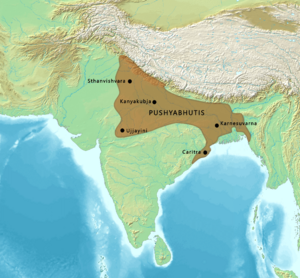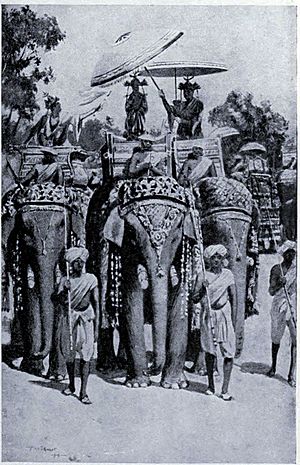Harsha facts for kids
Quick facts for kids Harsha |
|
|---|---|
| Maharajadhiraja | |

Coin of Harshavardhana, circa 606–647 CE.
|
|
| Ruler of North India | |
| Reign | c. 606 – c. 647 CE |
| Predecessor | Rajyavardhana |
| Successor | Arunāsva |
| Born | 590 CE, Thanesara , India |
| Died | 647 CE, Kannauj, India |
| Dynasty | Vardhana (Pushyabhuti) |
| Father | Prabhakarvardhana |
| Mother | Yasomati |
| Religion | Shaivism, Buddhism |
Harshavardhana (born around 590 CE) was a powerful Indian emperor. He ruled a large part of northern India from 606 CE until 647 CE. Harsha belonged to the Vardhana dynasty. His father, Prabhakaravardhana, was famous for defeating invaders called the Alchon Huna. Harsha was also the younger brother of Rajyavardhana, who was a king of Thanesar (in present-day Haryana).
During his time as emperor, Harsha supported Buddhism. He built many stupas (Buddhist monuments) across his empire. At the peak of his power, Harsha's empire covered most of northern and northwestern India. The Narmada River marked its southern border. He later made Kannauj (in present-day Uttar Pradesh) his capital city. Harsha tried to expand his empire further south, but he was defeated by Emperor Pulakeshin II of the Chalukya dynasty in the Battle of Narmada.
Harsha's reign brought peace and wealth to his kingdom. His royal court became a popular place for scholars, artists, and religious visitors from many different places. A famous Chinese traveler named Xuanzang visited Harsha's court. Xuanzang wrote good things about Harsha, praising his fairness and kindness. Harsha's life story, called Harshacharita ("Deeds of Harsha"), was written by the Sanskrit poet Banabhatta. This book tells us about Harsha's connection to Thanesar and describes his palace.
Contents
Harsha's Early Life and Family
Most of what we know about Harsha's younger years comes from the writings of Bāṇabhaṭṭa. Harsha was the second son of Prabhakarvardhana, who was the king of Thanesar. After the Gupta Empire fell in the mid-6th century, northern India broke into many smaller kingdoms. Prabhakara Vardhana, from the Vardhana family, began to control nearby states. He was the first king of the Vardhana dynasty, with his capital at Thaneswar.
When Prabhakar Vardhana died in 605 CE, his oldest son, Rajya Vardhana, became king. Harsha Vardhana was Rajya Vardhana's younger brother. This family line of kings is often called the Vardhana dynasty. During the visit of the Chinese traveler Hwen Tshang, Kanoj was the capital of King Harshvardhan. Xuanzang described Harsha as the most powerful ruler in Northern India at that time.
How Harsha Became King

Harsha's sister, Rajyashri, was married to King Grahavarman of Maukhari. Sadly, King Grahavarman was defeated and killed by King Devagupta of Malwa. Rajyashri was then put in prison. Harsha's brother, Rajya Vardhana, who was king of Thanesar, was very upset by this. He marched his army against Devagupta and defeated him.
However, a king named Shashanka from Gauda (in Eastern Bengal) then tricked Rajya Vardhana. Shashanka pretended to be a friend but secretly worked with the Malwa king. He then treacherously killed Rajya Vardhana. Meanwhile, Rajyashri managed to escape into the forests. When Harsha heard about his brother's murder, he immediately decided to fight against Shashanka. This fight did not have a clear winner, and Harsha eventually turned back.
Harsha became king when he was just 16 years old. His first important tasks were to find and rescue his sister and to get revenge for the deaths of his brother and brother-in-law. He found his sister just as she was about to give up hope.
Harsha's Rule and Empire
After the Gupta Empire ended, North India was divided into many small states. Harsha managed to unite these small states, from Punjab to central India. In April 606 CE, representatives from these states crowned him king, giving him the title of Maharaja. Harsha built an empire that brought all of northern India under his control.
The peace and wealth during his rule made his court a lively place. Many scholars, artists, and religious people from far away came to visit. The Chinese traveler Xuanzang visited Harsha's court and wrote very positively about him. He praised Harsha's fairness and generosity.
In the winter of 618–619 CE, Pulakeshin II stopped an invasion led by Harsha near the Narmada River. After this, Pulakeshin and Harsha made a peace treaty. The Narmada River became the border between their two empires. Xuanzang described this event, saying that Harsha, despite his confidence, could not defeat Pulakeshin.
In 648 CE, the Tang dynasty emperor Tang Taizong of China sent an ambassador to India. However, when the ambassador arrived, Harsha had already died. A new king, Aluonashun (likely Arunāsva), attacked the Chinese ambassador and his group. The ambassador escaped to Tibet and then led a joint army of over 7,000 Nepalese and 1,200 Tibetan soldiers to attack the Indian state. This attack was successful.
During Harshvardhan's rule, the Vardhan dynasty's lands stretched widely. They went from North to South, from Nepal to the Narmada River. From East to West, they reached from Assam to Gujarat. Harsha had friendly relations with King Bhaskarvarman of Kamrup. He also sent his own ambassador to the Chinese King, forming good relationships. Harshvardhan made Kannauj his state's capital. He used a large part of his kingdom's money to help his people. He was known for giving away his wealth every five years.
Harsha's Religious Beliefs
Like many ancient Indian rulers, Harsha had a mix of religious views. His official seals show that his ancestors worshipped the sun. His older brother was a Buddhist, and Harsha himself was a Shaivite (a worshipper of the god Shiva). His land grants describe him as Parama-maheshvara, meaning a supreme follower of Shiva. His court poet Bana also said he was a Shaivite.
Harsha wrote a play called Nāgānanda. This play tells a story about a Buddhist hero, and its opening prayer is dedicated to the Buddha. However, Shiva's wife, Gauri, also plays an important part in the play.
According to the Chinese Buddhist traveler Xuanzang, Harsha was a very devoted Buddhist. Xuanzang wrote that Harsha made rules against killing animals for food. He also built monasteries in places where Gautama Buddha had visited. Harsha built thousands of tall stupas along the Ganges river. He also set up well-kept hospices (places for travelers and poor people to stay) along highways across India. He organized a yearly meeting for scholars from all over the world and gave them gifts. Every five years, he held a big assembly called Moksha. Xuanzang also described a 21-day religious festival in Kannauj. During this festival, Harsha and other kings performed daily rituals before a large golden statue of the Buddha.
Since Harsha's own records show he was a Shaivite, it is thought that he might have become more interested in Buddhism later in his life. Even Xuanzang mentioned that Harsha supported scholars of all religions, not just Buddhist monks. Some historians believe that Harsha was personally a Shaivite. They think his support for Buddhists might have made Xuanzang believe he was a Buddhist.
Harsha's Writings
Many people believe that Harsha wrote three Sanskrit plays: Ratnavali, Nagananda, and Priyadarsika. Some scholars think that one of Harsha's court poets, Dhāvaka, wrote the plays for him. However, others, like Wendy Doniger, are convinced that King Harsha truly wrote these plays himself.
Harsha in Popular Culture
In 1926, an Indian silent film called Samrat Shiladitya was made about Emperor Harsha. It was directed by Mohan Dayaram Bhavnani.
See also
 In Spanish: Jarsha Vardhana para niños
In Spanish: Jarsha Vardhana para niños
- Surasena Kingdom
- History of India
- Bhaskar Varman





